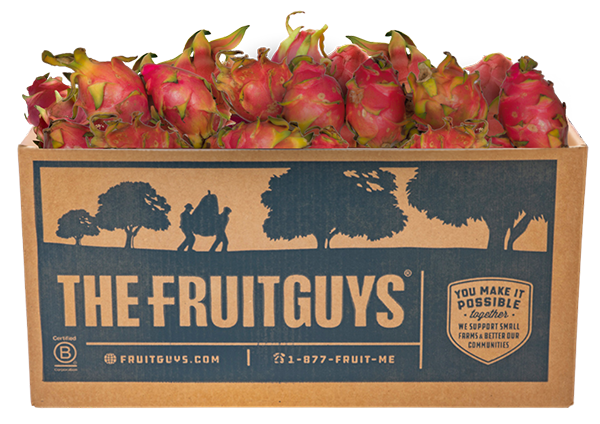10 Exotic Fruits That Will Surprise and Delight Your Employees
- By Elisabeth Flynn
- Reading Time: 7 mins.
Sometimes we all need a break from the everyday routine. Why not spice things up at the office and surprise your staff with a colorful assortment of exotic fruits? From vibrant dragon fruits to juicy lychees, these unique varieties are not only healthy snacks but also great conversation starters. You can get an exotic fruit delivery from a company like The FruitGuys to get people in your office talking—and tasting something new.
Here are ten fruits to consider next time you’d like to shake things up.
1. Dragon Fruits
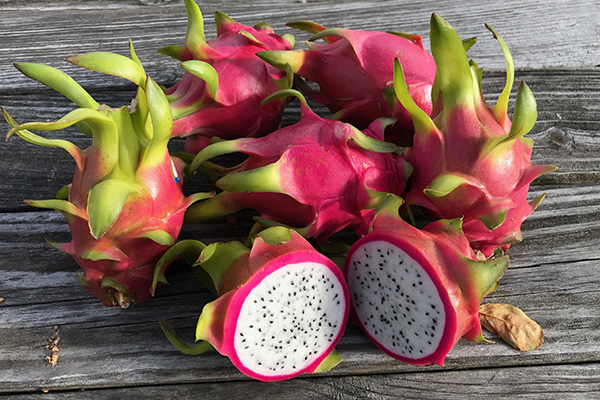
The dragon fruit, also known as pitaya, is a visually striking specimen. Technically a cactus fruit, its outer skin is vibrant, typically pink or yellow, with scales or spikes that resemble a dragon’s fiery, scaly hide. (Hence the cool name.) Despite its wild look, dragon fruit has a mildly sweet, refreshing flavor—sometimes likened to a blend of kiwi and pear.
Dragon fruit is a good source of vitamins C and B, as well as fiber. And the tiny black seeds are packed with healthy fats, including omega-3 fatty acids. They add a pleasant crunch to every bite. You can cut your dragon fruit in half lengthwise and scoop the flesh out with a spoon, or cut it into cubes for a yogurt bowl or fruit salad.
2. Guavas
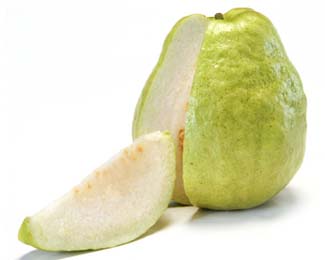
The guava is a delightful and delicious tropical fruit that’s also a nutritional powerhouse. This fruit can vary in appearance, but usually has a round or oval shape, with green or yellow skin. On the inside, guava can range from pale yellow to deep, rosy pink. The flavor is sweet and slightly tangy, often described as a combination of pear, strawberry, and citrus.
Guava is loaded with Vitamin C, which helps boost the immune system and promote skin health. It’s also rich in dietary fiber, supporting digestive health and keeping you feeling full longer. This versatile fruit is easy to eat fresh (slice it like an apple and enjoy it skin, seeds, and all) and also tastes great as a juice or an add-on to a smoothie or cocktail.
3. Rambutans

The name “rambutan” comes from the Malay word rambut, which means hair. That makes sense when you see the spiky, soft spines that appear on the fruit’s skin. Typically red or yellow in color, the rambutan may look like something out of science fiction, but as The FruitGuys Produce Buyer Miguel Robles said, “Once you get past their scary appearance and get in there, it’s a really good fruit to eat.”
Rambutans are high in antioxidants and dietary fiber, as well as Vitamin C.
“They’re sweet, and they have kind of a grape-like texture,” Miguel explained, adding: “When it’s picked off the tree, a rambutan is really bright red with green tips. Then, over time, as it ripens, it turns black. I think it tastes better when it’s black—that just means it doesn’t have much time left.”
4. Lychees
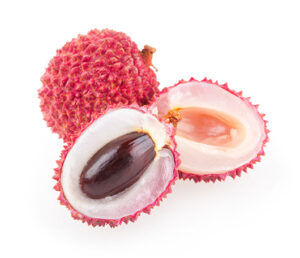
With their striking pink-red peel and refreshing bite, lychees are more than just eye candy. Tucked inside this small, rough-skinned fruit is a tasty surprise: translucent, juicy flesh that’s sweet, floral, and just a little tangy. This tree fruit is native to China and Southeast Asia, and dates back at least 2,000 years.
You may have seen lychees used as a cocktail garnish or on a dessert menu, but they’re delicious when eaten fresh as a snack or mixed into a salad. Low in calories and rich in fiber, their flavor has been compared to strawberries, pears, and citrus fruits.
5. Buddha’s Hands
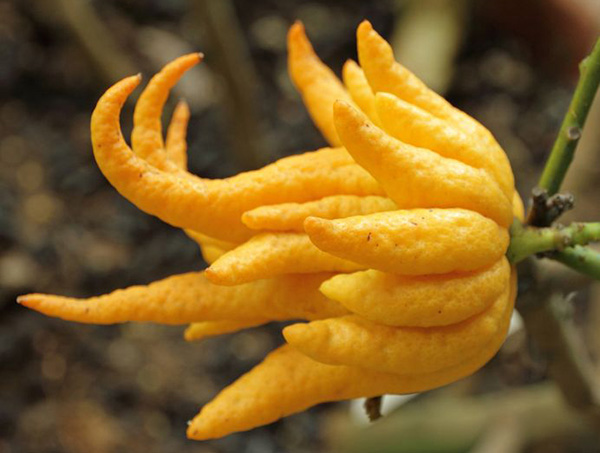
With bright yellow “fingers” that stretch outward like a surreal sculpture, this fruit symbolizes happiness and longevity in Chinese culture, where it’s traditionally given as a New Year’s gift.
Sandra Bertelli of Ripe to You, which grows multiple citrus varieties in California’s San Joaquin Valley, told The FruitGuys that Buddha’s Hand is “one of the oldest citrus fruits, and very visually striking.” (Ripe to You contributes Buddha’s hands and other fun fruits to The FruitGuys’ exotic fruit deliveries for offices and schools.)
Unlike most citrus fruits, Buddha’s hand has virtually no pulp or juice inside. It’s valued for its intense, lemony aroma, which gives this fruit many uses.
“It’s used for zesting, and in liqueurs and sauces,” Sandra said, adding, “It can be candied, sliced, or shredded and put in a salad.” Its distinctive appearance also adds flair to fruit displays. “It’s like a snowflake. Every single one is different,” Sandra said. “Put one of these out and everyone will stop and take a look.”
6. Kumquats
At first glance, you might take the kumquat for a small orange. But some of its attributes may surprise you. Kumquats have sweet, thin, edible skin—but their flesh is tart like a lemon. They’re packed with a powerful dose of Vitamin C, as well as fiber. As Ripe to You’s Sandra explained, kumquats come in many varieties, including the oval-shaped Nagami, with its “zesty citrus taste” and the larger, fleshier Fukushu.
You can eat kumquats whole (complete with the rind) for a unique blend of sweet and tart flavors. You can also slice them thinly and add them to salads or desserts. The name “kumquat” is believed to derive from the Cantonese for “golden orange”—a fitting name for these vibrant, flavorful fruits. Pop a few in a bowl at the office, and they’ll disappear fast.
7. Mandarinquats
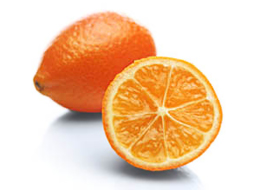
The bell-shaped mandarinquat is a particular favorite of Sandra and her colleagues at Ripe to You. She described it as a “sweet hand fruit … a cross between a mandarin and a kumquat.” This delightful hybrid citrus is bursting with character, from its sunny color to its bold, tangy flavor.
Mandarinquats look like miniature, egg-shaped oranges with a smooth, deep-orange peel. But you don’t need to peel them—just pop the whole thing in your mouth! Like kumquats, the sweet, edible skin balances perfectly with the tart, tangy flesh, making each bite a zesty, refreshing treat. Mandarinquats tend to be larger and juicier than kumquats, with a slightly sweeter peel.
On the nutrition front, mandarinquats are a great source of vitamin C and fiber (thanks to that edible peel). They’re fun to eat, mess-free, and perfect for powering through the mid-afternoon slump.
8. Mangosteens
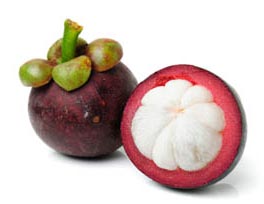
The late New York Times writer and editor R.W. Apple, Jr. once wrote of the mangosteen: “Merely typing the name makes my mouth water. Whenever in my travels I spot a mound of those precious orbs in a marketplace, my heart pounds.”
Other famous fans include Britain’s Queen Victoria, who in the late nineteenth century was rumored to have offered a reward to anyone who could bring her a fresh mangosteen. Unfortunately, in her era, the logistics made it impossible.
Today, it’s still considered a delicacy, often referred to as a “superfruit” for its potential health benefits. With its deep purple rind and soft, snow-white segments inside, mangosteen is a showstopper in both looks and taste.
Crack open the thick, leathery shell and you’ll find a juicy interior that tastes like a blend of peach, pineapple, and citrus. It’s sweet, slightly tangy, and smooth. Beyond its good looks and great flavor, the mangosteen is also a rich source of dietary fiber, antioxidants, and vitamins.
9. Passion Fruits
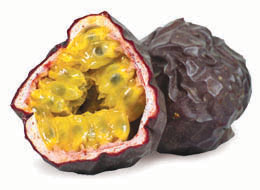
On the outside, the passion fruit looks a bit like a leathery plum—round to oval, with a thick purple or yellow rind. But slice it open, and you’ll discover a soft, jelly-like center filled with crunchy black seeds and a tropical aroma. The taste blends sweet and tart together like a citrus-mango mash-up.
You can eat passion fruit straight from the shell or spoon it over yogurt, oatmeal, or salads. Passion fruit juice is a popular additive to juices and smoothies. You can even make it into a syrup and use it to top all kinds of desserts.
Loaded with active plant compounds, including carotenoids and polyphenols, passion fruit may help to manage blood sugar and support heart health.
Fun fact: the name has nothing to do with romance. The term “passion” came from Spanish missionaries in South America who associated its unique flower with the Passion of Christ.
10. Finger limes
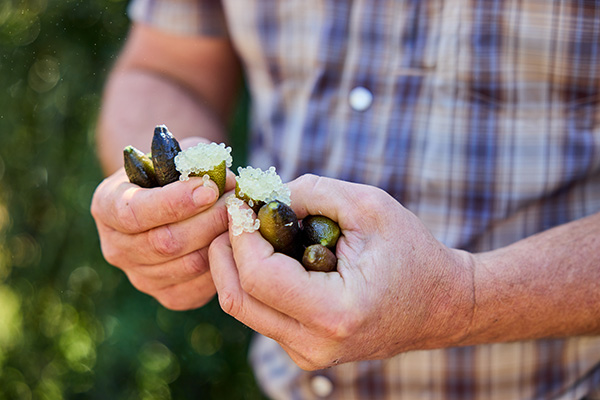
This tiny citrus boasts a big flavor pop. Finger limes are unassuming on the outside, but slice one open and you’ll discover why these little gems are sometimes called “citrus caviar.”
Typically 2–4 inches long, finger limes have thin, bumpy skin that ranges in color from green to deep red. But the real surprise is inside: tiny, pearl-like juice vesicles that resemble caviar and burst with zesty lime flavor when you bite into them.
Native to Australia, finger limes were traditionally used by Indigenous Australians for both food and medicinal purposes. They’re packed with Vitamin C and antioxidants, which support immune health and may help reduce inflammation.
As Megan Shanley Warren of Shanley Farms described them to The FruitGuys: “Finger limes are really a combination of tartness and sweetness. … You squeeze out the pearls, then crunch on them, and that’s where you get this pop of citrus flavor in your mouth.”
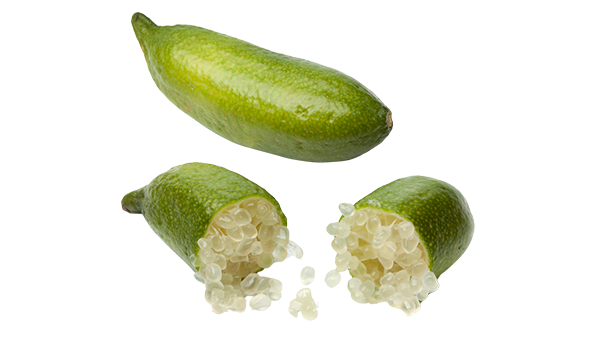
Based in Morro Bay, California, Shanley Farms has approximately 10,000 finger lime trees, making it the largest grower in the US. Megan’s family has supplied The FruitGuys with finger limes for its exotic fruit delivery business since 2023.
Megan often packs the fruit in her kids’ lunch boxes (“They eat these finger limes like candy,” she said). And her family likes to sprinkle the finger lime “pearls” over foods like sushi, oysters, or tacos, where their distinctive bright flavor enhances every bite.
Finger limes are becoming a favorite of gourmet chefs worldwide for their unique texture and intense flavor. Add them to your office fruit rotation for a burst of citrusy joy—and maybe a little culinary flair!
How to Schedule an Exotic Fruit Delivery
The FruitGuys can make your mangosteen and kumquat dreams come true. To see which fruits are available for bulk exotic fruit delivery in your area, visit the Marketplace by the Case page and choose your region.
